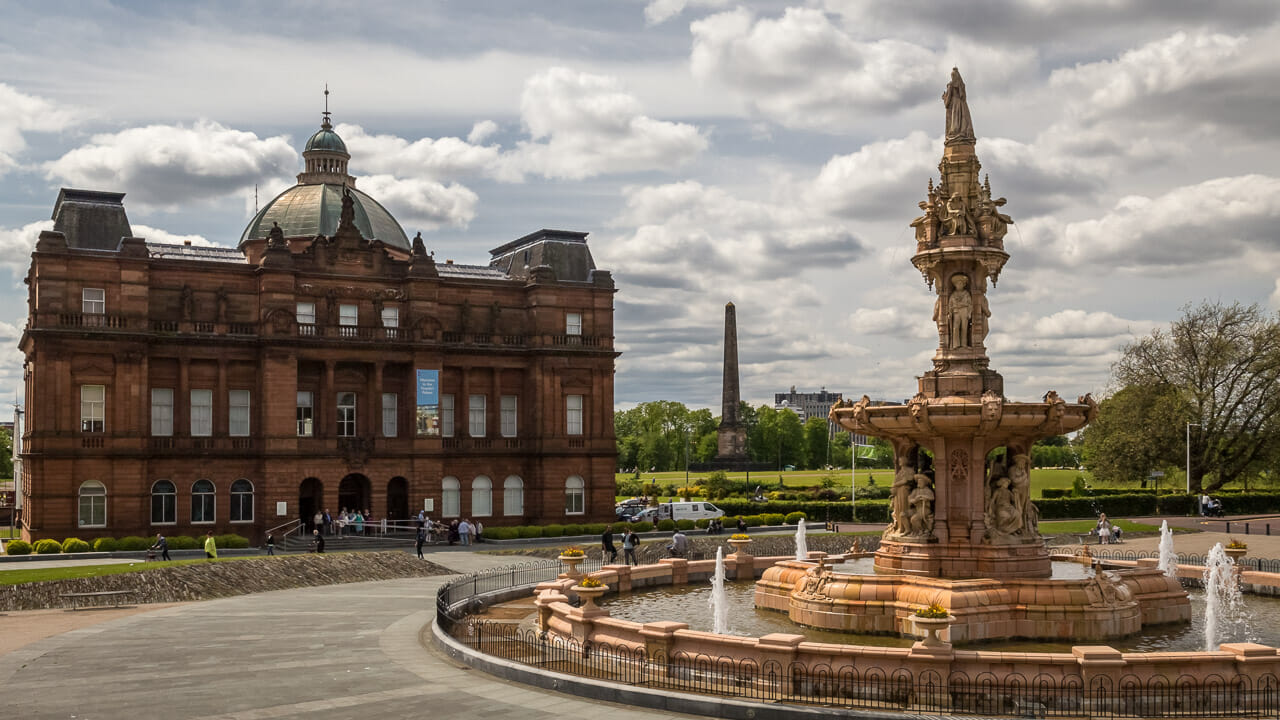A palace for the poor – the People’s Palace in Glasgow was designed to provide education and recreation for people in one of the city’s poorest neighbourhoods. Today it does this for visitors from all over the world.

Closed: From 14 April 2024, the museum will close for three years. During this time, the building and the exhibition will be remodelled. it is due to reopen in 2027.
“A palace of joy and imagination to which the people can address their affections and which will give them a home and on which their memory will rest” – these were the words used by the fifth Earl Rosebery to describe the function of the People’s Palace when it opened in 1898.
As pompous as the words sound today, for the inhabitants of the east end of Glasgow they represented real hope. People lived in an overcrowded and impoverished neighbourhood – hygiene was a foreign concept, as were recreation and aesthetics. The People’s Palace was built to bring a little joy to Glaswegians.
“Palace” is no exaggeration. The style of the two-storey house is reminiscent of the late French Renaissance. However, the typical Scottish red sandstone hardly emphasises this similarity.
But how could another large and dark house convey beauty to the inhabitants of East Glasgow, who were already crammed into cramped flats? This is where the Winter Garden comes in, a magnificent building made of iron and glass. Spacious and flooded with light on the inside. And wonderfully green.
While the front area is still open for seating today, paths lead into the garden at the back and still display exotic plants.
The location chosen for the People’s Palace is steeped in history. The building sits at one end of Glasgow Green, a long park that has repeatedly been the site of important events in Glasgow’s history.
Today, Glasgow Green looks tidy and clean. But it wasn’t always like this. When the park was gifted to Glasgow’s Bishop Turnbull and the people by the King himself in 1450, the land was an uneven marsh, crossed by the Molendinar Burn. Today, however, the river can no longer be seen here either; it lies underground, just as it did in the north at the Glasgow Necropolis.
Cattle could graze on Glasgow Green and clothes were washed at the rivers.
Over time, however, those responsible cultivated the park. Monuments were erected, such as the 44 metre high Nelson Obelisk in 1806, which commemorated the hero of the British Navy even before the famous column in London.
Over time, Glasgow Green attracted other landmarks, which were rearranged here as if they were furniture. The McLennan Arch, a kind of triumphal arch, for example, was once part of public assembly rooms. When these were demolished, the arch was moved three more times before it found its current location at the west end of Glasgow Green.
Another traveller is the Doulton Fountain, a wonderful fountain that now stands directly in front of the People’s Palace.
Originally, the round waterspout was erected near the Kelvingrove Museum as part of the Great Exhibition. It was later moved to Glasgow Green and placed in front of the entrance to the People’s Palace after it opened.
Doulton Fountain is dedicated to the then reigning Queen Victoria on her jubilee. That is why it stands at the top, with soldiers below it. The four sides of the column represent the four colonies of the time: Canada, India, South Africa and Australia.
Incidentally, Doulton Fountain is the largest ceramic fountain in the world. It is mainly made of terracotta.
And that brings us back to the People’s Palace. It is the crowning glory of this recreational area in the centre of Glasgow, which was once dedicated to the city’s residents but is now open to people from all over the world.
Knowledge: The history of Glasgow in the People’s Palace
But what will visitors find in the building? In the past, the three levels were strictly divided: a reading room downstairs, a museum in the centre and an art gallery upstairs. Today, almost everything is a museum dedicated to the history of the city.
The exhibits are quite large, for example the kitchen of a certain era has been completely recreated.
Or shelters against attacks.
Entire shop fronts were built inside.
Supplemented by photos and explanatory panels, visitors are given an interesting insight into life in Scotland’s largest city over the last few centuries.
Tip: Templeton’s factory with its unique façade
There is a special building not far from the People’s Palace. It is Templeton’s Carpet Factory, which today houses a business centre. In order to be allowed to build the factory in the centre of the city, Templeton had the façade designed in the style of the Doge’s Palaces in Venice.
Unfortunately, I missed taking a good photo of the factory.
How to get there:
The park is in the middle of the city centre, so the best way to get there is by public transport. Buses leave from near the Gallery of Modern Art, for example, including routes 18, 64 and 263.
Alternatively, you can take one of the hop-on hop-off sightseeing buses from George Square directly to the People’s Palace.
Or you can walk from George Square for about twenty minutes through the city.